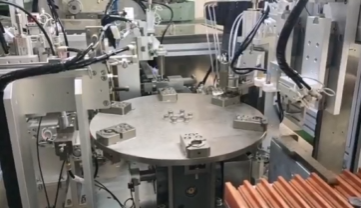What are the common mechanical failures and solutions for brushless motor motor automatic needle bearing press-in machine?
The common mechanical failures and solutions of brushless motor motor automatic needle bearing press-in machine are as follows:
1、Insufficient or unstable pressing force
Failure performance: needle roller bearings can not be completely pressed into the specified position, or in the process of pressing the pressure is sometimes large and sometimes small, resulting in unstable quality of pressing.
Failure causes
Hydraulic system failure: hydraulic pump wear, resulting in insufficient output pressure; hydraulic oil leakage, so that the system pressure can not be established; hydraulic valve clogging or damage, affecting the flow of hydraulic oil and pressure control.
Mechanical transmission parts wear: such as belt, chain loose or worn, resulting in power transmission is not smooth; gear wear, so that the transmission ratio is inaccurate, affecting the transmission of the indentation force.
Wear or deformation of the indenter: after long-term use, the surface of the indenter is worn or deformed, and the contact area and pressure distribution with the needle bearings are not uniform, resulting in insufficient or unstable indentation force.
Solution
Check the hydraulic system: replace the worn hydraulic pump; find and repair the hydraulic oil leakage point and replenish the hydraulic oil; clean or replace the clogged or damaged hydraulic valve.
Adjust or replace mechanical transmission parts: adjust the tension of belts and chains, or replace badly worn parts; check the wear of gears and replace them if necessary.
Repair or replace the press head: repair or replace the worn or deformed press head to ensure good contact between the press head and needle bearing.

2、Pressing position deviation
Failure performance: the position of needle roller bearing press-in is not in line with the design requirements, offset, tilt and so on, affecting the performance and assembly quality of the brushless motor.
Failure causes
Failure of positioning device: the positioning pin is worn, loose or damaged, and it is impossible to accurately determine the press-in position of the needle bearing; the positioning fixture is deformed or inaccurately installed, resulting in displacement of the workpiece in the press-in process.
The table surface is not flat: the table surface is worn and deformed after long-term use, which makes the workpiece tilted in the process of placing and pressing, and leads to the deviation of the pressing position.
The installation of the press-in mechanism is not vertical: the press-in mechanism is not adjusted to the vertical state during installation, so that the direction of the press-in force is not perpendicular to the surface of the workpiece, resulting in the offset of the needle roller bearing during press-in.
Solution
Check and repair the positioning device: Replace the worn or damaged positioning pins; correct or replace the deformed positioning fixture and readjust the installation position to ensure accurate positioning.
Repair the working table surface: Grind or mill the uneven working table surface to make it level again; if the working table surface is seriously damaged, consider replacing the working table.
Adjustment of the press-in mechanism: use a level meter and other tools to readjust the installation position of the press-in mechanism so that it is perpendicular to the working table surface.
3、Mechanical stagnation
Failure performance: In the process of running the press-in machine, there is a sudden stop, the action is not smooth or can not normally complete the press-in action.
Failure causes
Debris into the moving parts: processing of metal chips, dust and other debris into the guide rail, slide and other moving parts, increasing friction, resulting in stalling.
Lubrication system failure: insufficient supply of lubricant or lubricant deterioration, can not effectively lubricate the moving parts, so that the friction increases.
Component deformation or damage: guide rail, slider and other components due to long-term force or collision deformation, damage, affecting the smoothness of movement.
Solution
Clean up the moving parts: disassemble and clean up the guide rail, slider and other moving parts, remove debris and ensure that the surface of the moving parts is clean.
Check the lubrication system: check whether the lubricant pump, oil pipeline is clogged, timely cleaning or replacement; replacement of deteriorated lubricant, to ensure that the moving parts get good lubrication.
Repair or replacement of damaged parts: repair or replace the deformed guide rail, slider and other parts to restore the normal state of moving parts.
4、Noise abnormality
Failure performance: the press-in machine in the operation of abnormal noise, such as harsh friction, impact sound.
Failure causes
Damaged bearings: The bearings in the press-in machine are worn out and ruptured after long-term use, resulting in unstable operation and noise.
Loose parts: loose bolts, nuts and other connecting parts produce vibration and noise when the equipment is running; poor installation of transmission parts such as pulleys, gears, etc. will also lead to abnormal noise.
Mechanical collision: the gap between the moving parts is too small, and collision occurs during operation; or there are foreign objects interfering with the moving parts, generating noise.
Solution
Replacement of bearings: Check the wear and tear of the bearings and replace the damaged ones.
Tighten the connecting parts: check and tighten all the loose bolts and nuts; re-install the transmission parts to ensure firm installation.
Adjust the gap between parts and remove foreign objects: adjust the gap between moving parts to make them meet the design requirements; remove foreign objects in the equipment to avoid interference.
※ If you still can't solve the equipment failure through the above ways and means, please contact the technical specialist of Xinhui Mechanical & Electrical Equipment Co.







